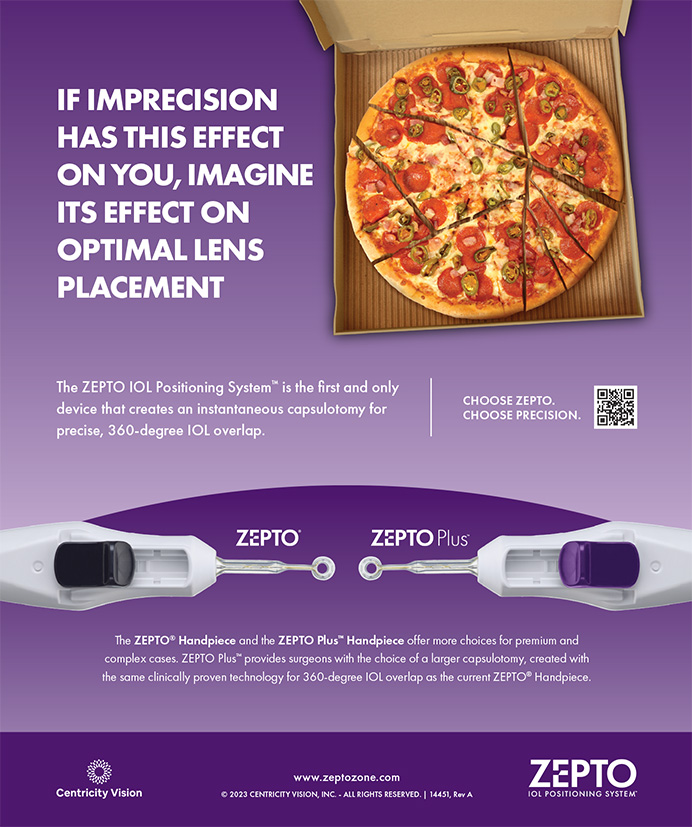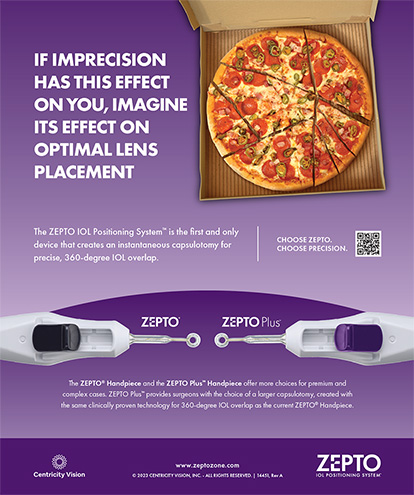In recent years, advances in cataract surgical techniques and IOL technology have provided better refractive outcomes. These improvements have led to an increase in patients' expectations, including spectacle independence for distance vision. Unfortunately, approximately two-thirds of cataract surgery patients have substantial corneal astigmatism (> 0.75 D), which traditional IOLs cannot reduce or eliminate. Thus, there are approximately 14 million Americans for whom traditional IOL technology is incapable of providing spectacle independence for distance vision.1,2
Toric IOLs to correct astigmatism have been under development for more than a decade. Issues with rotational instability, however, have marred the success of these lenses. Rotational movement is a considerable problem for toric lenses; studies report significant rotation (> 15° or 20°) in 16% to 25% of cases.3-6 Rotation degrades a toric IOL's corrective power by 3.3% for every degree the lens turns off axis.7 Rotations of more than 30°, therefore, may actually induce additional astigmatism. Newer toric lenses must offer improved rotational stability before they can achieve optimal efficacy and widespread acceptance.
Alcon Laboratories, Inc. (Fort Worth, TX), recently updated the single-piece, acrylic AcrySof IQ Toric IOL. This design provides spherical as well as astigmatic correction. In addition, the AcrySof Toric lens now has an aspheric design that improves contrast sensitivity. The advantages of this lens are its unique haptic design and a bioadhesive material that improves the IOL's conformance to the capsular bag.8,9 This adherence enhances the stability of the lens and minimizes rotation. Furthermore, improvements in IOL instrumentation and injection systems and surgeons' better understanding of astigmatic correction have led to improved outcomes. Despite the advantages that new technologies offer, however, surgeons must adhere to fundamental principals to optimize their results. This article discusses my pearls for success with toric IOLs.
PEARL NO. 1
Astigmatism is more prevalent than traditionally recognized
Approximately 35% of the cataract population has 1.00 D or more of corneal cylinder, and 85% of this target population has moderate (1.00 to 2.00 D) corneal astigmatism.
PEARL NO. 2
Differentiate corneal cylinder from refractive astigmatism
There are three types of astigmatism: corneal, lenticular, and mixed. Extracting the cataract removes any astigmatism derived from the lens and leaves the cornea as the only source of astigmatism. Manual keratometry and computerized corneal topography are the best ways to identify and quantify preexisting corneal cylinder. Surgeons should use these measurement techniques preoperatively to plan the surgery and determine the cylindrical power of the toric IOL to implant.
PEARL NO. 3
Differences exist between various toric IOL models
Two manufacturers market toric IOLs in the United States: STAAR Surgical Company (Monrovia, CA) and Alcon Laboratories, Inc. The first toric IOL approved by the FDA was the STAAR Toric IOL, a silicone-based, single-piece, plate-style lens. It is available in two powers (approximately 1.50 D and 2.25 D at the spectacle plane). In the STAAR FDA clinical trial, out of 124 patients, 24% of the implanted lenses rotated greater than 10°. This amount of rotation reduces the attempted cylindrical power by 30%, and hence this lens had a high repositioning rate. The IOL used in the FDA clinical trial was 10.8 mm in overall length; since then, a longer STAAR Toric IOL (11.2 mm) has become available. In a nonrandomized study of 34 consecutive implantations of the longer IOL, 65% were within 5° of the target axis, 91% were within 10° of the target axis, and 100% were within 15° of the target axis.10 In a 50-patient study of consecutive cases, the repositioning rate of the longer STAAR Toric IOL was zero.11
In contrast, the AcrySof Toric IOL is a single-piece, open-loop, hydrophobic acrylic lens, available in three cylindrical powers (approximately 1.00, 1.50, and 2.00 D at the spectacle plane). FDA clinical results showed excellent rotational stability with this lens, with 80% of patients experiencing 5° or less of rotation and 97% having 10° or less of rotation.
PEARL NO. 4
Surgeons must consider the effect of surgically induced astigmatism to determine the appropriate toric IOL and the correct axis for implantation
The incision that the surgeon uses will affect both the magnitude and direction of the ultimate cylinder to be corrected. Therefore, it is important to account for the amount of cylinder induced by the surgical incision in order to determine the correction of the total cylinder.
Manufacturers have developed toric calculators that use vector analysis and account for surgically induced astigmatism to aid surgeons in determining the correct axis of the toric IOL's placement and its power. The accuracy and ease of using these calculators have made them invaluable in maximizing outcomes with toric IOLs. I routinely use www.acrysoftoriccalculator.com. Determining a toric IOL's power and axis using these calculators requires entering the keratometric measurements, IOL power determined by biometry, desired location of the incision, and amount of surgically induced astigmatism.
PEARL NO. 5
Proper alignment of the toric IOL is critical in optimizing the postoperative result
Implanting a toric IOL requires only minor variation from a standard cataract extraction/IOL implantation procedure. After surgeons perform a standard phaco procedure through the clear corneal incision, they should follow three important steps: IOL calculation; marking the eye; and IOL alignment (on axis).
MARKING THE EYE
Because the eyes of patients who are placed in a supine position often cyclorotate, surgeons need to make reference marks on the cornea preoperatively. With the patient sitting upright in the preoperative area, the surgeon should place ink marks in at least two locations at the limbus (usually the 3- and 9-o'clock positions). This demarcates the 180° meridian and will serve as the reference point for the placement of the intraoperative axial marks. Surgeons should place the axial marks intraoperatively following the removal of the cataract and identify the optimal axis of the toric IOL's placement, as determined by the toric calculator. These axial marks are also placed at the limbus using the preoperative reference marks to ensure accurate alignment. Various markers and instruments are available to perform these steps, each usually possessing some type of circular compass degree markings.
IOL ALIGNMENT
Aligning the IOL involves three steps. After the surgeon places the toric IOL in the capsular bag with an ophthalmic viscosurgical device (OVD) still in the eye, he or she performs gross alignment of the lens by rotating it clockwise to approximately 20° to 30° short of the desired position (Figure 1). Next, the surgeon stabilizes the toric IOL as he or she removes the OVD with I/A and takes care to prevent the IOL from rotating past the intended final desired axis. He or she can accomplish this step in a number of ways, such as using a bimanual I/A tip, a silicone tip, or a second instrument (Figure 2). The surgeon then finalizes the IOL's alignment by carefully rotating it clockwise and aligning the marks on the IOL precisely onto the intended axis of alignment denoted by the intraoperative axial marks. This is most easily achieved by using continuous irrigation to maintain the depth of the anterior chamber while rotating the lens with a second instrument such as a Sinskey hook through a separate incision (either a paracentesis or the surgical incision) (Figure 3).
IN SUMMARY
Toric IOLs enable surgeons to offer a great service to their patients and provide an easy segue into the refractive cataract marketplace. Compared with presbyopia-correcting IOLs, toric IOLs are easier to incorporate into your practice; the latter demand much less chair time, commitment to staffing, educational development, and practice-process retooling. Following these pearls will streamline the transition to using toric IOLs.
Stephen S. Lane, MD, is a managing partner of Associated Eye Care in St. Paul, Minnesota, and is an adjunct clinical professor for the University of Minnesota in Minneapolis. He is a consultant to Alcon Laboratories, Inc., but he acknowledged no financial interest in the products or companies mentioned herein. Dr. Lane may be reached at (651) 275-3000; sslane@associatedeyecare.com.


